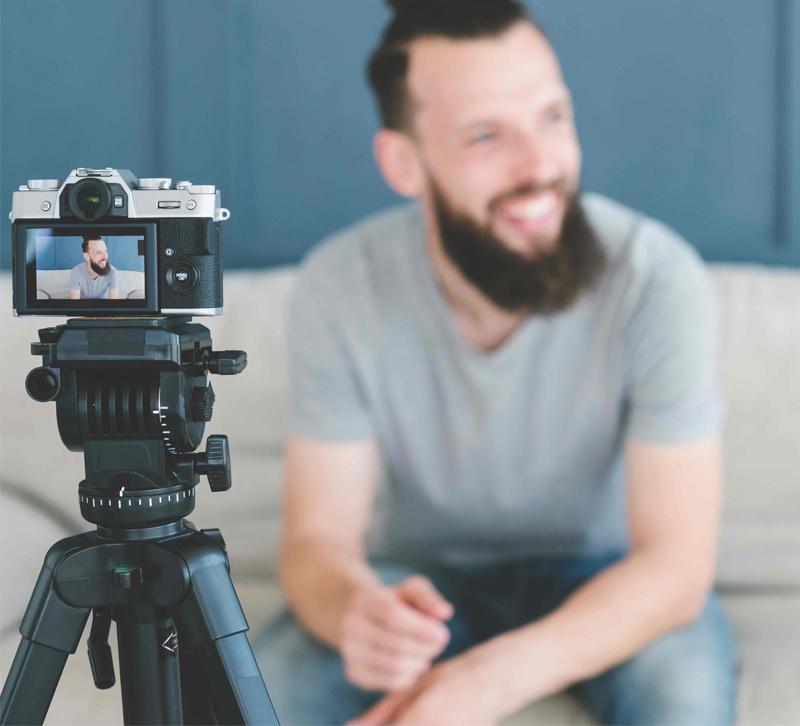Our consumer research from last year found that when faced with a problem designing their homes, 46 percent of respondents said they go to YouTube for instructional videos. As the second largest search engine after Google, YouTube can be an unmatched tool for connecting with consumers, demonstrating your expertise and increasing your brand awareness. The idea of buying new equipment and learning video skills may be keeping you from getting into video marketing, but it’s possible to produce your own quality video content without a big budget. Here’s how video marketing experts recommend making videos that look sleek, but have a small-budget production.
Use What You Have
When it comes to filming a video, CEO Jace Vernon at digital marketing agency Marketing Hy says it’s a misconception that you need an expensive camera to create strong content.
“I actually get better conversions off of a video if I just pull out my phone and shoot it than I do on a full production,” he says.
With your smartphone in hand, the only other filming equipment you might need is a smartphone tripod to stabilize your filming and a mic to pick up quality audio. Vernon recommends searching Amazon and choosing the best items for your needs and budget (he says his mic was about $12 and works great).
When it’s time to edit, there’s no need to download pricey software — if you have a Mac, Vernon recommends using iMovie, which comes free on your computer. If you have a PC, he recommends Screencast-O-Matic or Camtasia as affordable options. While these programs are fairly simple to learn, checking out YouTube tutorials can help you get started.
Keep it Simple
As for the content of your videos, Sara Thomas, Vice President at Charlton Marketing, says how-tos and product demos work great because they demonstrate your expertise and they don’t need to be high quality.
“Those are all things that really lend themselves great to DIY video because people aren’t expecting a really high production value,” she says.
Given the growth of influencers on YouTube shooting with their smartphones, audiences are increasingly seeking realness and personality in online video. Jason Hsiao, Chief Video Officer and Co-founder at video creation service company Animoto, says high production quality can actually be off-putting.
“Super high production videos start to look like advertisements, and I think people these days — especially on social — they care more about authenticity and stuff that kind of looks real and human, so it doesn’t have to be perfect,” he says.
Using your own talent on camera is free and conveys your authenticity. Once you’ve found an associate who you think will shine on camera, Thomas recommends keeping that person consistent in your videos to reinforce your brand story.
While it can be tempting to go a bit overboard with editing techniques and video length, Thomas cautions to keep your videos as clear and concise as possible.
“Shorter is always better,” Thomas says. “So when you think you’ve got the video to where you feel like ‘this is a good length,’ take even more time off of it.”
Hsiao adds that especially for YouTube, it’s important to limit your video to a single focused topic or question a viewer might have. Ultimately, he says, home furnishings businesses have an advantage when it comes to video given the beauty in the industry.
“It’s a visual product, and so that by nature already makes communicating through video a big leg up,” he says. “This type of stuff has already proven to be popular content on social. People love watching this stuff and they love sharing this stuff. It’s aspirational.”
Shooting Tips
So you’re ready to start shooting marketing videos on your smartphone — here are some key parts of the process to keep in mind.
- Create an outline: Every good film starts with a script, and the same goes for a minute-long internet video. Write out exactly what you want said (both on camera or off-camera if you do voiceover) and think ahead of time about what exact shots you want to get. Draw out approximate sketches of the shots you want if that helps you visualize.
- Shoot horizontal: Especially for YouTube, you’re going to want horizontal video, so make sure you’re not holding your phone vertically like you usually would when you go to film.
- Light your subject properly: Bad lighting can ruin a video, and bright, even lighting can make your video pop. For affordable lighting options, Thomas recommends the Godox A1 Wireless Flash or the Xuma Mobile Daylight.
- Use your camera’s exposure lock: If you’ve ever tried to take a photo of a moving subject before, you’ve probably noticed that your phone adjusts the exposure based on the focus of the shot. On video, these adjustments won’t look great, so turn on your smartphone exposure lock to keep the look consistent.







